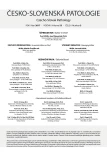Changes of the WHO classification of myeloid neoplasms in the context of the 2016 revision
Authors:
Juraj Marcinek 1,2; Tomáš Balhárek 1,2; Lukáš Plank 1,2
Authors‘ workplace:
Konzultačné centrum bioptickej diagnostiky ochorení krvotvorby v SR
Ústav patologickej anatómie Jesseniovej lekárskej fakulty Univerzity Komenského a Univerzitnej nemocnice v Martine
1; Konzultačné centrum bioptickej diagnostiky ochorení krvotvorby v SR
Martinské bioptické centrum, s. r. o. v Martine
2
Published in:
Čes.-slov. Patol., 53, 2017, No. 3, p. 118-121
Category:
Reviews Article
Overview
Continual progress of knowleges in hematopathology and genetics of hematologic tumors requires actualisation of widely accepted and presently used WHO classification of myeloid neoplasms published 8 years ago. However, the basic principles of this classification remain unchanged, therefore the authors of new WHO classification mention the „revision“ of previous and not the introduction o new classification. The aim of this paper is to outline the most important changes of myeloid neoplasm diagnostics to pathologists, hematologists and other clinicians in Czech Republic and Slovakia. This review is based on several papers recently published by opinionleaders in this field.
Keywords:
WHO classification – myeloid neoplasms – diagnostic criteria
Sources
1. Swerdlow SH, Campo E, Harris NL, et al. (Eds): World Health Organization classification of tumours of haematopoietic and lymphoid tissues. Lyon, IARC Press, 2008, 133 s.
2. Arber DA, Orazi A, Hasserjian R, et al. The updated WHO classification of hematological malignancies. The 2016 revision to the World Health Organization classification of myeloid neoplasms and acute leukemia. Blood 2016; 127(20): 2391-2405.
3. Deininger MW. Diagnosing and managing advanced chronic myeloid leukemia. Am Soc Clin Oncol Educ Book, 2015; 35: e381-e388.
4. Tefferi A, Thiele J, Vannucchi AM, Barbui T. An overview on CALR and CSFR mutations and a proposal for revision of WHO diagnostic criteria for myeloproliferative neoplasms. Leukemia 2014; 28(7): 14078-1413.
5. Barbui T, Thiele J, Vannucchi AM, Tefferi A. Myeloproliferative neoplasms: Morphology and clinical practise. Am J Hematol 2016; 91(4): 430-433.
6. Madelung AB, Bondo H, Stamp I, et al. World Health Organization-defined classification of myeloproliferative neoplasms: morphological reproducibility and clinical correlations-the Danish experience. Am J Hematol 2013; 88(12): 1012-1016.
7. Thiele J, Kvasnicka HM, Müllauer L, Buxhofer-Ausch V, Gisslinger H. Essential thrombocythemia versus early primary myelofibrosis: a multicenter study to validate the WHO classification. Blood 2011; 117(21): 5710-5718.
8. Maxson JE, Gotlib J, Pollyea DA, et al. Oncogenic CSF3R mutation in chronic neutrophilic leukemia and atypical CML. N Engl J Med 2013; 368(19): 1781-1790.
9. Meggendorfer M, Bacher U, Alpermann T, et al. SETBP1 mutations occur in 9% of MDS/MPN and in 4% of MPN cases and are strongly associated with atypical CML, monosomy 7, iscochromosome i(17)(q10), ASXL1 and CBL mutations. Leukemia 2013; 27(9): 1852-1860.
10. Mughai TI, Cross NC, Padron E, et al. An international MDS/MPN Working Group´s perspective and recommendations on molecular pathogenesis, diagnosis and clinical characterization of myelodysplastic/myeloproliferative neoplasms. Haematologica 2015; 100(9): 1117-1130.
11. Font P, Loscertales J, Benavente C, et al. Interobserver variance with the diagnosis of myelodysplastic syndromes (MDS) following the 2008 WHO classification. Ann Hematol 2013; 92(1): 19-24.
12. Della Porta MG, Travaglino E, Boveli E, et al. Rate Ematologica Lombarda (REL) Clinical Network. Miminal morphological criteria for defining bone marrow dysplasia: a basis for clinical implementation of WHO classification of myelodysplastic syndrome. Leukemia 2015; 29(1): 66-75.
13. Papaemmanuil E, Gestung M, Malcovati L, et al. Chronic Myeloid Disorders Working Group of the international Cancer Genome Consortium. Clinical and biological implications of driver mutations in myelodysplastic syndromes. Blood 2013; 122(22): 3616-3627.
14. Steensma DP, Bejar R, Jaiswal S, et al. Clonal hematopoiesis of indeterminate potential and its distinction from myelodysplastic syndromes. Blood 2015; 126(1): 9-16.
Labels
Anatomical pathology Forensic medical examiner ToxicologyArticle was published in
Czecho-Slovak Pathology

2017 Issue 3
Most read in this issue
- Lymph node metastasis of Merkel cell carcinoma without known cutaneous primary - case report
- Changes of the WHO classification of lymphoid neoplasms in the context of the 2016 revision
- Isolated infectious endocarditis of the pulmonary valve: a case report
- Changes of the WHO classification of myeloid neoplasms in the context of the 2016 revision
